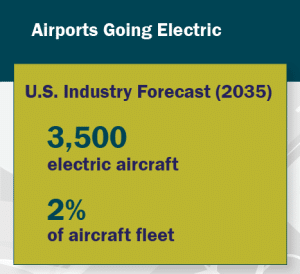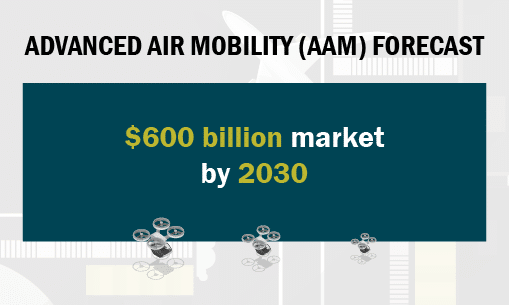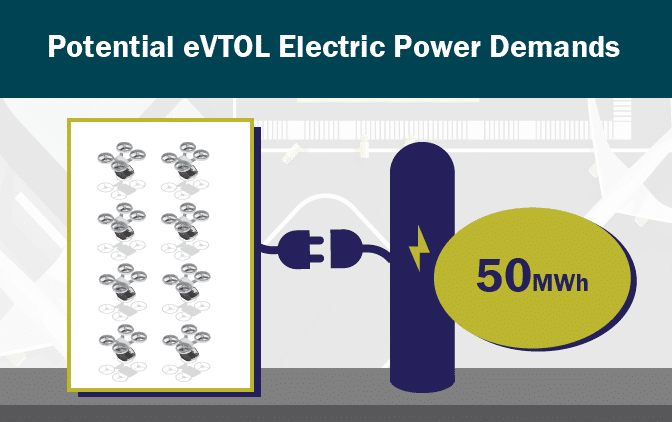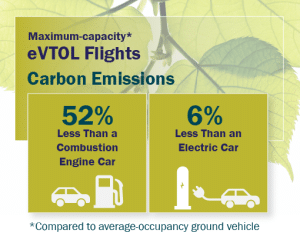Advanced Air Mobility Takes Flight
The concept of Advanced Air Mobility (AAM) envisions safe, efficient, low-carbon transportation made possible with the advent of lightweight, short-range aerial craft technology, known as electric Vertical Takeoff and Landing (eVTOL) aircraft.
eVTOLs may help to avoid the gridlock of congested roadways and shorten delivery speeds for critical cargo. Forecasts predict eVTOLs will account for 2 percent of the U.S. aircraft fleet by 2035.
Although wide-scale adoption may be several years off, airport planning efforts are well underway.
Mass Transit Goes Airborne
About 300 firms are currently developing eVTOL technologies. Of these, the U.S. National Aeronautics and Space Administration (NASA) identified 17 companies to participate in readiness exercises, testing passenger- and cargo-carrying technologies within urban environments.
Once early prototypes mature and initial regulations are put in place, eVTOL trips are expected to become commercially viable by 2028. Initially, eVTOL flights will likely serve as luxury alternatives to chartered flights or — perhaps sooner — for short-distance cargo delivery. Early applications may include rural cold-chain medicine and vaccine distribution.
The AAM industry eventually plans to provide equitable hub-to-hub transportation for the general public. Several eVTOL models can already carry between two and seven passengers. One prototype offers capacity for 40 passengers or 10,000 pounds of cargo.
Federal and local agencies are laying the groundwork. The Federal Aviation Authority (FAA) is developing protocols to facilitate certification of new aircraft, critical operational facilities, and flight procedures. Cities like Houston, Los Angeles and Orlando are advancing plans for regional network of take-off and landing facilities, known as “vertiports.”
In Los Angeles, for instance, an eVTOL may soon be able to fly the 330-mile trip to San Francisco within an hour. As market adoption grows, AAM prices could drop from $4 per passenger-mile to rates that would make eVTOL flights cheaper than a typical Los Angeles taxi fare.
AAM startups have suggested designs featuring a take-off area similar to a heliport landing pad. Passengers board and disembark at a parking stand that would also be equipped for eVTOL charging, cleaning and maintenance. Larger operations would likely require construction of entirely new terminals.
Vertiport Infrastructure Challenges
It remains uncertain where exactly vertiports will be developed and how they will be designed. Locations may include new standalone facilities or integration within existing transport terminals, commercial centers, or high-rise residences.
For any vertiport facility, AAM infrastructure will need to address the unique challenges of battery-powered aircraft and air travel operations. Vertiports will require significant investments in specialized infrastructure such as:
- Charging infrastructure and power supplies
- Security systems
- Air-traffic control technologies
Powering eVTOL Flight
Equipping vertiports with power supplies for fast-charging systems will likely become the main cost of eVTOL implementation. In addition to powering the charging stations, vertiports will need capacity to support landing-zone lighting systems and ground markers, as well as the electrical loads of parking stands and terminals.
At a time when electrification efforts are already increasing electricity loads and adding strain to an aging grid, AAM sites may need significant upgrades to power supplies and electrical distribution systems.
At airports, for example, the combination of new demand from eVTOLs, electric vehicles, and electrification of terminal facilities may lead peak electrical loads to double in the next 20 years, according to an Airport Cooperative Research Program study.
To ensure the resilience of vertiport facilities, operators may need to integrate distributed energy resources such as solar photovoltaics or battery energy storage systems. Back-up power supplies will become necessary in the event of power disruptions and could provide peak-shaving capabilities for instances when charging activities prompt a surge in demand.
Ensuring Vertiport Safety and Security
For many AAM developers, security is typically a consideration within the context of how operators can protect eVTOL or vertiport assets. Security risks may include cybersecurity threats, unauthorized access to restricted vertiport areas, or common issues such as larceny or property damage.
If eVTOLs eventually offer passenger service, however, more comprehensive evaluation of AAM security protocols will become necessary. Vertiport designs would need to include systems for screening and transferring passengers in a manner aligned with federal aviation standards.
ntegrating AAM with secure airport environments would also require collaboration with airports and FAA to ensure each airport’s Perimeter Intrusion Detection System (PIDS) understands how to identify eVTOLs as an authorized aircraft upon entering the airside.
For now, AAM proposals mostly focus on travel connections between non-secure locations, such as a downtown area and an airport parking lot. Outside secure locations, many specialized security systems will still need to be incorporated within the standard vertiport design. Advanced security cameras, access control systems, and supportive information technology networks will all need to be considered.
The sensitive nature of charging large eVTOL batteries will also require specialized fire-suppression systems, arc flash protection, and other safety measures. Otherwise, vertiports risk being exposed to thermal runaway — the buildup of heat within damaged battery cells — that could trigger fires in adjacent batteries. Systems designed for traditional fuel–powered aircraft will likely be insufficient should an emergency occur.
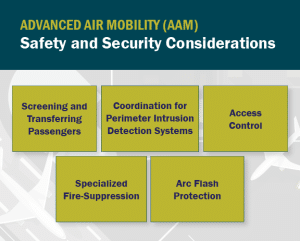
Intelligent Air-Traffic Management
For an eVTOL to enter an airport ecosystem, AAM operators would also need to become interoperable with existing air-traffic control technology. FAA is already working with AAM startups to develop new certification rules.
In the meantime, multiple communications and operations systems will need to be developed and standardized between AAM operators and traditional commercial air-traffic management systems.
Currently, the Global Navigation Satellite System (GNSS) provides airspace surveillance, backed up by ground-based navigational aids. Communications, navigation, and surveillance technologies are designed for aircraft that keep their distance using see-and-avoid procedures.
AAM operators will rely on intelligent data systems rather than voice communications
These systems, however, are not suitable for surveilling AAM traffic. eVTOL will likely require smaller separation standards, flying closer to buildings and other aircraft.
To do so, AAM operators will rely on intelligent data systems rather than voice communications. 5G-and-beyond cellular services will likely need to be established to facilitate communication between aircraft and traffic control. Private 5G networks could also be deployed to support air-to-ground communications, eVTOL tracking and remote identification, command-and-control systems, and other functions.
Planning for Advanced Air Mobility
AAM offers the promise of greater convenience, affordable mobility, and reduced traffic congestion. If powered by renewable electricity, eVTOLs can provide a more environmentally beneficial travel option, reducing greenhouse gas emissions and improving air quality.
Fulfilling these promises will require proactive planning on behalf of local governments and airport authorities. Though AAM adoption may seem years away, capital upgrades are often planned decades in advance.
Industry and government planning efforts are already yielding significant progress. In June, FAA released a draft Engineering Brief (EB) on safety-critical vertiport design elements. This fall, the National Safe Skies Alliance’s Program for Applied Research in Airport Security (PARAS) will release a guidance document on AAM security concerns, potential airport countermeasures, and near-term AAM operational models for both cargo and passenger service.
Continued collaboration between AAM manufacturers, airport authorities, government agencies, and aviation industry stakeholders can hasten development of the critical infrastructure necessary to bring about safe, secure, resilient, and reliable vertiport operations.
Air taxis are no longer technologies of the future. eVTOLs will take flight sooner than many realize. The time to prepare for critical AAM infrastructure has arrived.
Featured photo courtesy of Wisk.



